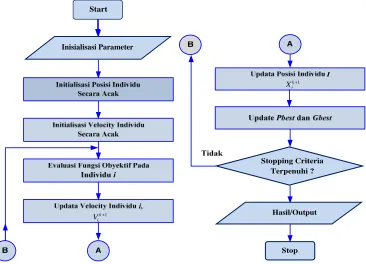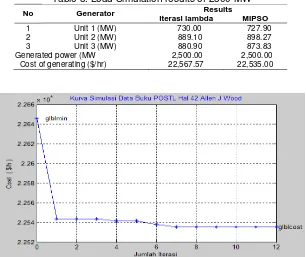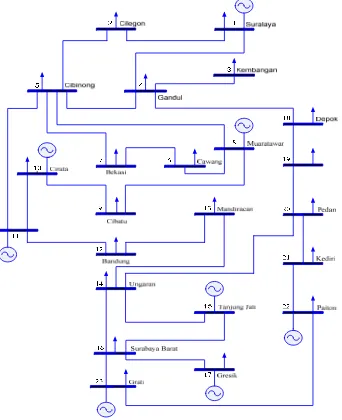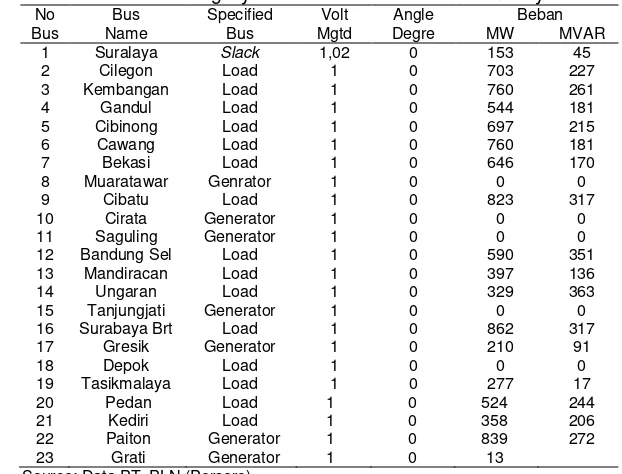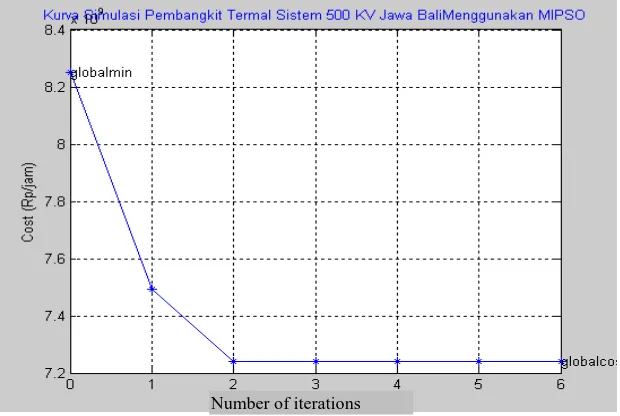ISSN: 1693-6930
accredited by DGHE (DIKTI), Decree No: 51/Dikti/Kep/2010 459
Economic Dispatch Thermal Generator Using Modified
Improved Particle Swarm Optimization
Andi Muhammad Ilyas*, M. Natsir Rahman
Khairun University Ternate, North Maluku, Indonesia Jl. Pertamina, Telp/Fax. (0921) 3121356 HP. 081247412198
e-mail: [email protected]*
Abstrak
Biaya bahan bakar generator termal merupakan fungsi bebannya sendiri. Dalam penelitian ini, Optimasi Particle Swarm yang dimodifikasi dan ditingkatkan (MIPSO) telah diterapkan untuk menghitung pengoperasian ekonomi. Pendekatan faktor penyempitan (CFA) digunakan untuk memodifikasi algoritma IPSO karena kemampuannya untuk meningkatkan pencarian global dan menghindari diri untuk terjebak dalam nilai minimum yang lokal, sehingga waktu yang dibutuhkan untuk mencapai konvergensi menjadi lebih cepat. Hasil simulasi yang diperoleh dengan menggunakan metode MIPSO terjadi pada saat beban puncak 9602 MW dengan biaya pembangkitan yang diperoleh adalah Rp 7.366.912.798,34 per jam, sementara biaya pembangkitan dari sistem nyata adalah Rp. 7.724.012.070,30 per jam. Dari hasil simulasi dapat disimpulkan bahwa MIPSO dapat mengurangi biaya pembangkitan sistem transmisi Jawa - Bali 500 kV sebesar Rp 357.099.271,96 per jam atau sama dengan 4,64%.
Kata kunci: MIPSO, CFA, Opereasi Ekonomis (ED)
Abstract
Fuel cost of a thermal generator is its own load functions. In this research, Modified Improved Particle Swarm Optimization (MIPSO) is applied to calculate economic dispatch. Constriction Factor Approach (CFA) is used to modify IPSO algorithm because of the advantage to improve the ability of global searching and to avoid local minimum, so that the time needed to converge become faster. Simulation results achieved by using MIPSO method at the time of peak load of of 9602 MW, obtained generation cost is Rp 7,366,912,798,34 per hour, while generation cost of real system is Rp. 7,724,012,070.30 per hour. From the simulation result can be concluded that MIPSO can reduce the generation cost of 500 kV Jawa Bali transmission system of Rp 357,099,271.96 per hour or equal to 4,64%.
Keywords: MIPSO, CFA, Economic Dispatch (ED)
1. Introduction
Optimal power flow analysis using to minimize the cost of electricity generating is commonly known as the Economic Dispatch. Economic dispatch is the distribution of loading on generating units that exist in the optimal economic system on a particular load system. By applying economic dispatch, it will get the minimum generation cost of production of electric power generating units generated at an electrical system [1-4].
Large electric power systems that have coal-fired thermal power plant such as, diesel and power plant will face problems in terms of fuel costs for its operation. Therefore, it is necessary for an effort to reduce operating costs through reduced fuel costs to a minimum level. Methods for producing and distributing electric power economically is being studied intensively by researchers engaged in this issue. The problem is then how to regulate the imposition of the power plant, so the amount of electrical energy generated in accordance with the requirements and production costs to a minimum as well as taking into account the demands of the service [1], [5-7].
I.N. Kassabalidis et. al. [10], has described the identification of safety limits on power systems by using the Enhanced Particle Swarm Optimization. M.A. Abido [7], have been successfully used algorithm of Particle Swarm Optimizations techniques in the design of multimachine optimal power system stabilizers (PSS).
Economic dispatch is used to divide the power to be generated by each generation of a number of existing plants to meet system load requirements are aimed at getting the minimum fuel costs. Therefore, to obtain the total minimum cost of fuel, the method Improved Modified Particle Swarm Optimization (MIPSO) in the calculation of economic dispatch with equality and inequality constraints is used. Equality constraints reflect a real balance of power and inequality constraints reflect the minimum and maximum generation that must be met in order to obtain the total minimum cost of fuel. Coal-fired optimized in this study is thermal power system 500 kV Java-Bali interconnection working at peak load.
The main advantages of PSO algorithm is the concept which is simple and easy to implement.it has only two coefficients in the calculation of acceleration and efficient when compared to mathematical algorithms and other heuristic optimization techniques [5].
2. Economic Dispatch
2.1. Basic Formulation of Economic Dispatch
Economic dispatch is the distribution of loading on each generating unit in order to obtain a combination of generating units to meet load requirements in a optimum cost. In general, the cost function of each generator can be formulated mathematically as an objective function as given in the following equations [1-3], [5]:
∑
At the equilibrium of power, equality constraint must be satisfied which the total power generated by each generator should be equal to the total load demand on the system.
Equality is the power balance constraint as follows:
∑ =
2.3. Maximum and Minimum Limit of Power Plant
The output of each generating unit has the minimum and maximum generation to be
3. Research Method
3.1. The Standard PSO Algorithm
The standard PSO algorithm is found through a simulation model of a simplified animal social life associated with bird flocking, fishing scholing and swarm theory.
The standard PSO algorithm can be described as follows:
)
c1andc2are theaccelerationcoefficients,rand2 andrand1arerandom numbersbetween(0-1), Xi=(xi1,xi2,xi3...Xid)representsaparticleto the i.,Pi =(Pi1,Pi2,Pi3,...Pid)representsthe initial position of the particle to the i (a position that gives the best fitness value), the symbol g representstheindexof bestparticleamongall particlesin a population,Vi = (Vi1, Vi2, Vi3,...Vid) representsachange ofposition(velocity)ofparticle i. Equations (5) and (6) describe the trajectory equation of motion of a particle in a population. Equation (5) describes how the velocity is updated dynamically, Equation (6) updates the position of the particles motion using the velocity [11-12].
To prevent divergence in the standard PSO algorithm, particle velocity is controlled with a maximum velocity Vmax. If the velocity through the Vmax in each coordinate, then the velocity will be truncated at that value, so that the Vmax becomes an important parameter in PSO. If Vmax is too large, the particles can move quickly to get a good solution. If Vmax is too small, the particles crawl slowly and can not find a good solution so that the particles can be trapped in local optimum for not being able to move from attraction basin.
3.2. Improved Particle Swarm Optimization (IPSO)
Update velocity on indvidu i can be done by modifying the basic equation in the PSO algorithm using Inertia Weigth aproach (IWA) as follows:
)
At this velocity update process, the values of parameters such as w, c1 and c2 should be determined in advance. In general, weight parameter w obtained using the following equation Iter = number of actual iterations
Particle moving from an initial position to the next position by modifying the position of the individual using a modified velocity in Equation (7). Equation modification of individual position expressed in the following equation 9:
The following figure shows the concept of the search mechanism of PSO with the modification of velocity and position of individual i based on Equation (7) and (9) if the value of w, c1 and c2 rand1, rand2 are 1 [2], [5].
3.3. Chaotic Sequence
Chaotic sequence is one of the simplest dynamical system which shows a chaotic behavior. It is an iterator called function map (logistic map) [12]. The equation is as follows:
)
Although from the equation seems simple, but the solution shows that individual behaviorvaries greatly.Behavior ofthesystemrepresentedbyEquation(10) which is alteredby varying µ. Value of µbyf is stableat a constant size, moving betweena limited sequence of
measuresor behave randomly ina patternthat can not bepredicted andalso the behavior of thesystemis sensitive to the initial valueof f [14],[16]. Equation (9) isdeterministic, showing chaotic dynamicswhenµ=4.0andf0€{0,0.25,0.50,0.75,1.0}.
Concepts in the IPSO optimization based on chaotic sequences can be a good alternative to provide diversity in the population of the IPSO algorithm. However, in the long term,the behavior ofachaoticsystemshowsspecial stochasticpropertiesandnotequivalent to a random process. A chaotic motion can traverse every state in a certain portion, called the chaos space with regularity properties of its own and each state is only visited once, so no precisionin a given time[15].In this study, a technique combining thechaotic sequences with constrictionfactortoimprove theglobalsearchcapability is used.
3.4. Modified Improved Particle Swarm Optimization
Equation (7) and (8) is the basic equation of the modified PSO algorithm with inertia Weigth aproach (IWA). Weigth inertia is introduced to balance ability between global and local search [10]. Clerc introduced another parameter called Constriction Factor Approach (CFA) used to modify the algorithm of IPSO called Improved Modified Particle Swarm Optimization (MIPSO).
In general, researchers applied the constriction factor PSO algorithm by setting the value of c1 and c2 = 2.05 so that the obtained value of C = 0729. Algebraically equivalent to this value when using the inertia weight w = 0729 and c1 = c2 = 1.49445 [12].
In contrast to the evolutionary computation (EC) method to another, the CFA confirmed MIPSO algorithm converges on a search which is based on mathematical theory. MIPSO algorithm with Constricttion Factor Approach (CFA) can produce good solutions in comparison with algorithms that use ipso Inertia Weight Approach (IWA), although the CFA only consider the dynamic behavior of the particle or agent and the influence of particle interaction, where the equations has been developed with the best position to Pbest and Gbest, it may change during the search on the basis of PSO equation [10].
3.5. Implementation of the Economic Dispatch MIPSO
This section describes how the algorithm of Modified Improved Particle Swarm Optimization (MIPSO) implemented to solve the economic dispatch problem. MIPSO not only improves the existing algorithms IPSO but also provides a new strategy to find a global solution which is better than the standard PSO algorithm by applying the chaotic sequence parameters constriction factor [8],[10]. MIPSO algorithm process can be described in the figure below:
Start
Inisialisasi Parameter
Stop Hasil/Output Stopping Criteria
Terpenuhi ?
1
k i
V +
1
k i
X +
Figure 2 Flowchart Algorithm of MIPSO
3.5.1. Position and Velocity Initialization on Individuals
individual position of the operating point is set at the maximum/minimum by using the following
Although the methods above always yield the position of each individu which meet the inequality constraint Equation (4), but the question on the equality constraint must still be considered in order to continue to meet these constraints. Therefore, we need a new development strategy by summing all the elements in an individual that must equal to the total system load requirements. Equality constraint to resolve the issue, following the proposed procedure on each individual in a population/group:
Step 1, Set j = 1.
Step 2, Choose one element of the output power of an individu randomly and store in an index array A (n).
Step 3, Get the power output that meets the inequality constraint. Step 4, if j = n – 1 go to Step 5, or if j = j + 1 return to Step 2.
Step 5, the last element of an individual value obtained from the Expression PD - 1 0 1
Step 8, Stop the initialization process.
After earning the starting position in each individu, velocity or displacement of any individu can also be obtained randomly. The following equation is used to obtain the initial velocity of an individu:
randomly between the limits. Pbest is beginning of an individu i in the set as the initial position of an individu I and the initial Gbest defined as the position of an individu with a minimum value [2], [5].
3.5.2. Velocity update
To modify the position of each individu so that the position of individuals experiencing displacement from its original position, then the velocity should be calculated on the next stage which has been modified by using a constriction factor as given in Equation (11). This parameter is used to enhance the capabilities or performance of an individu in a global search.
3.5.3. Modified Position Individuals with Constraint
Position in each individual can be modified by using Equation (9), in order to obtain the position of the new individu. Therefore, individual who obtained a position with the modification can not be guaranteed to meet the inequality constraint. In other words, there is a violation of inequality constraints due to over or under velocity, then the position of the modified individual will be setback by using Equation (11). At the same time, equality constraint must be met as given in Equation (3).
To complete the equality constraints without the use of dynamic processes in MIPSO algorithm, a heuristic procedure is proposed as follows:
Step 2, Choose an element of the power of individual i randomly and store it in an index array A(n).
Step 3, Modify the value of the element j using Equation (9) and (13). Step 4, If j = n – 1 then go to Step 5, or if j = j + 1 return to Step 2. Step 5, The value of last element of an individual is determined by PD
-1
value is not within the limit then the value is set by using Equation (13) and will go to. Step 6, otherwise it will go to Step 8.
Step 6, Set i = 1.
Step 7, Set the value of the element in the make-up of the index j in A (n) the value that satisfy the conditions of the PD
-Step 8. Conversely, if not, change the value of the element i using Equation (11). Set i = i + 1 and go to Step 7. If i = n + 1 go to Step 6.
Step 8, stop the process of modification
3.5.4. Update Pbest dan Gbest
Pbest of each individual at iteration k + 1 is modified by using Equation (15):
1 1 1
TCI is the objective function evaluated at the position of individual i. Gbest at iteration k + 1 is set as the best position that has been evaluated as well as in [2], [5].
3.5.5. Stop Criteria
Iterative process stops when most optimum values of MIPSO algorithm are obtained in particle tracing, or if the iteration reaches the maximum iteration predetermined.
4. Results and Analysis
Simulations performed on two systems, namely: the first simulation with a system of three steam generating units with 2500 MW of power "in the User Data POSTL, page 42" Allen J. Wood ", while the second simulation with six thermal generating units at 500 kV Jawa-Bali power system during peak load Tuesday, March 17, 2009 Date, Time 19.30.
4.1. Data Sistem 2500 MW
The first simulation performed on three units of thermal power plant with 2500 MW system load data from the book "Power Generation, Operation and Control" by Allen J. Wood, with maximum and minimum limits of each generating unit as shown in Table 1 below:
Table 1. The 2500 Boundary Data System MV
No Generator Power (MW)
Generating units have generating cost function as follows:
Table 2. Cost Function System 2500 MW
4.1.2. The First Simulation
The simulation results of the three generating units using the Modified Improved Particle Swarm Optimization (MIPSO) compared to simulation results using lambda iteration method on the same load 2500 MW can be seen in Table 3. Table 3 shows that the calculation of economic dispatch using lamda iteration compared to MIPSO is able to reduce a charge of $32.57 or 0.1%. Curve of thermal power plant simulation results on three generating units with a load of 2500 MW system from the book "Power Generation, Operation and Control" by Allen J. Wood, using the MIPSO can be seen in Figure 4 below.
Table 3. Load Simulation results of 2500 MW No Generator Results
Iterasi lambda MIPSO
1 Unit 1 (MW) 730.00 727.90
2 Unit 2 (MW) 889.10 898.27
3 Unit 3 (MW) 880.90 873.83
Generated power (MW 2,500.00 2,500.00
Cost of generating ($/hr) 22,567.57 22,535.00
Figure 4. MIPSO curve using Load 2500 MW
The curve shows that the simulations are performed using MIPSO can converge on iteration of the seventh with an average of eleven iterations.
4.1.3. Analysis
The simulation is based on data from the book "Power Generation, Operation and Control" by Allen J. Improved MIPSO compared to simulation results using lambda iteration method on the same load 2500 MW is indicates that the method of MIPSO showed better results, namely $22,535.00/h while the using lamda iteration of $22,567.57/h. From the results of this simulation can be concluded that the MIPSO are capable to reduce generating cost of $32.57 or 0.1%. The results of simulations generating charts using the MIPSO gives a good convergence acceleration. This is due to the random starting position of a particle or an individual can affect the acceleration of convergence, so that the convergence value of the average achieved at iteration 12.
4.2. Data Transmission of Jawa-Bali 500 kV Interconnection System
Figure 4 Single-line diagram of 500-kV Jawa-Bali interconnection system
Table 5. Limitation of Thermal Power Plant of Jawa-Bali 500 kV Transmission System
No Generating units Power (MW)
Minimum Maximum
1 2 3 4 5 6
Suralaya Muaratawar Tanjung Jati
Gresik Paiton Grati
1500 1040 600 238 1425
150
3400 2200 1220 1050 3254 827
Table 6. Cost Function Generator Thermal Systems 500 kV Java-Bali
Station Cost function
Suralaya Muaratawar Tanjung Jati Gresik Paiton Grati
31630.21 + 395668.05 P1 -65.94 P12 107892572,17 + 2478064,47 P2+ 690,98 P22 -1636484.18+ 197191.763-21.88 32
4.2.1. Thermal Generating Data of Jawa-Bali 500 kV System
The second simulation performed on a thermal power Jawa-Bali 500 kV transmission systems by the number of generating units that operate the six units and the total load during peak load of 9602 MW. For more details of the data used in thermal generating simulation can be seen in the Table 5 and 6. The second case is carried out during peak load in the evening on Tuesday, March 17, 2009. The total peak load is equal to 9602 MW. Data loading on each bus can be seen in Table 7.
Table 7. Thermal Generating System of Jawa-Bali 500 kV Bus System
No Bus Specified Volt Angle Beban
Bus Name Bus Mgtd Degre MW MVAR
1 Suralaya Slack 1,02 0 153 45
2 Cilegon Load 1 0 703 227
3 Kembangan Load 1 0 760 261
4 Gandul Load 1 0 544 181
5 Cibinong Load 1 0 697 215
6 Cawang Load 1 0 760 181
7 Bekasi Load 1 0 646 170
8 Muaratawar Genrator 1 0 0 0
9 Cibatu Load 1 0 823 317
10 Cirata Generator 1 0 0 0
11 Saguling Generator 1 0 0 0
12 Bandung Sel Load 1 0 590 351
13 Mandiracan Load 1 0 397 136
14 Ungaran Load 1 0 329 363
15 Tanjungjati Generator 1 0 0 0
16 Surabaya Brt Load 1 0 862 317
17 Gresik Generator 1 0 210 91
18 Depok Load 1 0 0 0
19 Tasikmalaya Load 1 0 277 17
20 Pedan Load 1 0 524 244
21 Kediri Load 1 0 358 206
22 Paiton Generator 1 0 839 272
23 Grati Generator 1 0 13
Source: Data PT. PLN (Persero)
4.2.2. Second Simulation
The parameters used in the algorithm implements the MIPSO to resolve the economic dispatch of thermal power plant system is as follows:
PD = 9602 Total thermal load
e = 0.01 small positive real number
Pemb = 6 Number of plants (n)
Swarmsize = 50
Maximum iterations = 10000
AC1 = 2.05
AC2 = 2.05 Coefficient acceleration
The simulation results of thermal power plant using the Modified Improved Particle Swarm Optimization (MIPSO) at 9602 MW load can be seen in the following descriptions.
4.2.3. MIPSO Calculation
Calculations using MIPSO on Economic Dispatch showed total generation cost savings compared to real data system. More results using MIPSO is shown in Table 8.
Table 8. Simulation results of Thermal Plant
No Generator Results
Real Sistem MIPSO
1 Suralaya 3,593.69 3,398.40
2 Muaratawar 1,470.00 1,040.00
3 Tanjungjati 830.00 1,220.00
4 Gresik 810.00 539.60
5 Paiton 2,820.00 3,254.00
6 Grati 198.00 150.00
Power generated (MW) 9,721.69 9,602.00
Table8 showsthat the calculation ofeconomic dispatchusingMIPSO duringthe eveningpeak on 17March2009is able to reducethe costof Rp 357,099,271.96/h or4.64%.Curvesimulation are shown in Figure 5 below.
Figure 5Curve simulationwithModifiedCoefficientMIPSOconstriction
4.3. Analysis of Simulation Results
The simulation results obtained using the method of MIPSO at the time of the peak load on Tuesday, March 17, 2009 Stairs, Jam 19:30 pm with a load of 9602 MW generation cost obtained Rp 7,366,912,798.34/hour. While the cost of generating the real system of Rp 7,724,012,070.30/hour. From the results of this simulation can be concluded that the MIPSO capable to reduced cost of generating the transmission system 500 kV Jawa-Bali Rp 357,099,271.96/h or 4.64%. The results of simulations generating charts using the MIPSO gives a good convergence acceleration. This is due to the random starting position of a particle or an individual can affect the acceleration of convergence, so that the average convergence is achieved at iteration 6.
5. Conclusion
By using the MIPSO to calculate the economic dispatch of thermal power plant on the Jawa-Bali 500 kV transmission system can be deduced from the simulation results as follows: simulation results conducted on the thermal power plant 500 kV transmission system using the Jawa-Bali improved MIPSO at the time of peak load on Tuesday, March 17, 2009 at 19:30 pm with a load of 9602 MW generation cost of Rp 7,366,912,798.34/hour. While the cost of generating the real system of Rp 7,724,012,070.30/hour. From the results of this simulation can be concluded that the MIPSO capable to reduce generating cost the Jawa-Bali 500 kV transmission system Rp 357,099,271.96/h or 4.64%. Combination of power generated to meet the equality constraint and inequality constraints that have been determined for a total of 9602 MW of thermal load. With the method of MIPSO, faster iteration process converges to the minimum value can be obtained at iteration 6.
References
[1] J Wood Allen, F Wollemberg Bruce. Power Generation, Operation an Control. 2nd edition. 1996. [2] Sheng-Fu Zheng, Shan-Li Hu, She-Xiong Su, Chao-Feng Lin, Xian-Wei Lai. A Modified Particle
Swarm Optimization Algorithm And Application. Proceedings of the Sixth International Conference on Machine Learning and Cybernetics. Hong Kong. 19-22 August 2007.
[3] Jong-Bae Park, Yun-Won Jeong, Hyun-Huong Kim and Joong-Rin Shin. An Improved Particle Swarm Optimization For Economic Dispatch With Valve-Point Effect. International journal of Innovations in energy systems and power. November 2006; 1(1).
[4] C H Cheng, S N Yeh. Particle Swarm Optimization For Economic Dispatch With Valve-Point Effects. IEEE Transaction on power system. Maret 2006.
[5] Kwang Y Lee, Jong-Bae Park. Application Of Particle Swarm Optimization To Economic Dispatch Problem: Advantages and Disadvantage. IEEE Transaction on power system. Oktober 2006.
[6] Jong-Bae Park, Ki-Song Lee, Joong-Rin Shin, Kwang Y Lee. A Particle Swarm Optimization for Economic Dispatch With Nonsmooth Cost Fucntions. IEEE Transactions on power system. February 2005; 17(1).
[7] M A Abido. Optimal Design Of Power System Stabilizers Using Particle Swarm Optimization. IEEE Transaction energy conv. Sept. 2002; 17(3).
[8] H Yoshida, K Kawata, Y Fukuyama, S Takayama, Y Nakanishi. A Particle Swarm Optimization For Reactive Power And Voltage Control Considering Voltage Security Assessment. IEEE Transaction on Power System. November 2000; 15.
[9] Maurice Clerc. Particle Swarm Optimization. Great Britain and the United States: ISTE Ltd. 2006. [10] I N Kassabalidis, A El-Sharkawi, R J Marks, L S Moulin, A P Alves da silva. Dynamic Security Border
Identification Using Enhanced Particle Swarm Optimization. IEEE Transaction on power system. August 2002; 17(3).
[11] S Naka, T Genji, T Yura, Y Fukuyama. A Hybrid Particle Swarm Optimization For Distribution State Estimation. IEEE Transaction on power system. February 2003; 18(1).
